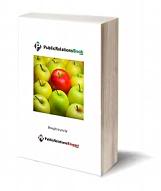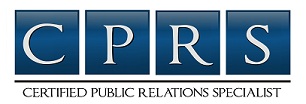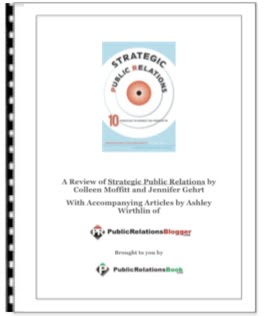________________________________________________________________________
 To many marketers, the press release is something of a "one size fits all" proposition. You want to get media coverage, you knock out a press release, send it to some journalists and sit back and wait.
To many marketers, the press release is something of a "one size fits all" proposition. You want to get media coverage, you knock out a press release, send it to some journalists and sit back and wait.
Of course, smart Publicity Insiders already know that’s a prescription for failure. You know that your press release has to have a "hook", be well-written and sent to appropriate journalists in an active, not passive, manner. But there’s another part of the puzzle that even savvy publicity-seekers sometimes miss -- you can’t just write "a press release", you have to write the right kind of press release.
There’s no such thing as a "one size fits all" release. Smart publicists have variations of the press release model ready to be go, depending on the occasion.
(Note: for a general introduction to press release writing and formatting, click here.)
Let's look at some releases suitable for "harder" and more timely news....
The News Release
To some folks, "news release" and "press release" are interchangeable. Not to me. I use the phrase "news release" to refer to a release that, well, carries actual news. Let’s face it, most of what a business has to say to a journalist isn’t exactly "stop the presses" kind of stuff. But, on occasion, something of real significance occurs. A merger, a stock split, a major new contract, winning a national award...something that’s truly timely and important. For these sorts of events, don’t mess around. Craft a solid, hard-hitting News Release that’s written in pure journalistic style (lead includes "who, what, when, why and how", language is in 3rd person and completely free of hyperbole). Use journalism’s "inverted pyramid" -- most important information at the top, next most important info in the second paragraph and so on down.
Tell the entire story in the headline and subhead. Again, don’t get cute -- get straight to the point. The headline Acme Corporation Selected by Pentagon to Supply Troops with Widgets is far better than something like Guess Who’s Making Widgets for Uncle Sam? or something "clever" like that. In the subhead, fill in some details: $18 Million Contract Largest in Company’s History. Talk about getting straight to the point! You’ve just given the journalist the meat of the story before she’s even read your lead.
Add a "dateline" (Akron, OH) at the beginning of your lead (first) paragraph. In the dateline, use your company’s home town (or the location where some news has broken. You can be a bit creative here, if it helps maximize your impact. For the above example, you can dateline it Washington, DC and say that "The Pentagon today announced that it has selected an Akron company...".
In distributing the release, use e-mail, fax, or even overnight courier. The goal is to get it into journalists’ hands on the same day you distribute it.
Executive Appointment Release
Most businesses send out a brief release and headshot when someone new is hired or a major promotion is made. That’s fine, and it will get them in the "People on the Move" column on page 8 in the business section. It’s an ego stroke for the employee, but that’s about it. Savvy publicity seekers use the Executive Appointment release to generate real publicity. Here’s the key -- don’t just announce that someone’s been hired or promoted. Rather, explain why the move is significant to the company -- and perhaps the market -- as a whole.
For example, Jane Smith has been hired as your company’s new director of sales. Not so exciting. However, the reason you hired her is because she came from a major online retailer and is planning to overhaul your sales system to compare with the state- of-the-art systems used by the big guys. Hmmmm...that’s a lot more interesting. So why not tell the media about it?
The key ingredient is context. Your headline may still look like that of a typical Executive Appointment release (Acme Names Jane Smith New Director of Sales), but starting with the subhead, you begin your journey off page 8 of the business section and onto page one (Hiring of Key Figure in Online Sales Explosion Marks Important Shift in Acme’s Sales Strategy). Ah, now you’ve entered the realm of news, not business as usual. And a sharp business editor will see that a local company is doing something far more significant than just making a hire.
Dateline the release, fax (or even messenger), email or regular mail it over to your local business editor and follow up with a phone call. Offer Jane Smith for interview, too.
The Media Alert
The Media Alert is a deceptively simple creature. It’s essentially a memo from you to TV, radio and newspaper assignment editors, city desk editors and others who decide whether a particular news event is worth covering. They’re used to alert the press about news conferences, charity events, publicity "stunts" and other events.
The point of the Media Alert is to, in just a few seconds, tell a journalist about the event, how to cover it and why it’s important that the media outlet, in fact, covers it. Most publicists are pretty good on the first two points -- almost all media alerts do a decent job of telling what the event is, where it will be held and what time it starts. It’s the third aspect -- the "why" -- that will make the real difference, though. And it’s the thing most publicists do a lousy of job of conveying.
First, a word about format. Use standard press release headings (contact info, "For Immediate Release" and headline). The rest of the document should be a few paragraphs, spaced at least three lines apart from one another. The first paragraph, should begin with What: and continue with a one or two line description of the event (WidgetFest 2004, a celebration of young minds). Next paragraph, When:, after that Where:
Now here’s the key paragraph,
Why You Should Cover WidgetFest 2004: The brightest young minds from around the region will gather to present their inventions, as Acme Corp. celebrates the state’s top high school science students. The event will be a visual feast, with a host of awe- inspiring inventions, many colorful, active and exotic, on display. As part of the event, more than $10,000 in scholarships will be distributed to budding Einsteins by John Smith, Ohio’s Science Teacher of the Year.
The key? This line: "The event will be a visual feast, with a host of awe-inspiring inventions, many colorful, active and exotic, on display." I just spoke an assignment editor’s language, telling him that this will provide lots of cool visuals, making for great video or photos. The bit about the scholarships and the Science Teacher of the Year assures him that this won’t just be a promotional stunt. So what are we offering? A non-promotional, feel-good event with great visuals. Just what an assignment editor is looking for.
Bill Stoller, the "Publicity Insider", has spent two decades as one of America's top publicists. Now, through his website, eZine and subscription newsletter, Free Publicity: The Newsletter for PR-Hungry Businesses, he's sharing -- for the very first time -- his secrets of scoring big publicity. For free articles, killer publicity tips and much, much more, visit Bill's exclusive new site.
Article Source.
Tags: writing press releases, tips, tailoring press releases, public relations
|

Tips to Creating Press Releases for Any Event or Occasion
________________________________________
 To many marketers, the press release is something of a "one size fits all" proposition. You want to get media coverage, you knock out a press release, send it to some journalists and sit back and wait.
To many marketers, the press release is something of a "one size fits all" proposition. You want to get media coverage, you knock out a press release, send it to some journalists and sit back and wait.Of course, smart Publicity Insiders already know that’s a prescription for failure. You know that your press release has to have a "hook", be well-written and sent to appropriate journalists in an active, not passive, manner. But there’s another part of the puzzle that even savvy publicity-seekers sometimes miss -- you can’t just write "a press release", you have to write the right kind of press release.
There’s no such thing as a "one size fits all" release. Smart publicists have variations of the press release model ready to be go, depending on the occasion.
(Note: for a general introduction to press release writing and formatting, click here.)
Let's look at some releases suitable for "harder" and more timely news....
The News Release
To some folks, "news release" and "press release" are interchangeable. Not to me. I use the phrase "news release" to refer to a release that, well, carries actual news. Let’s face it, most of what a business has to say to a journalist isn’t exactly "stop the presses" kind of stuff. But, on occasion, something of real significance occurs. A merger, a stock split, a major new contract, winning a national award...something that’s truly timely and important. For these sorts of events, don’t mess around. Craft a solid, hard-hitting News Release that’s written in pure journalistic style (lead includes "who, what, when, why and how", language is in 3rd person and completely free of hyperbole). Use journalism’s "inverted pyramid" -- most important information at the top, next most important info in the second paragraph and so on down.
Tell the entire story in the headline and subhead. Again, don’t get cute -- get straight to the point. The headline Acme Corporation Selected by Pentagon to Supply Troops with Widgets is far better than something like Guess Who’s Making Widgets for Uncle Sam? or something "clever" like that. In the subhead, fill in some details: $18 Million Contract Largest in Company’s History. Talk about getting straight to the point! You’ve just given the journalist the meat of the story before she’s even read your lead.
Add a "dateline" (Akron, OH) at the beginning of your lead (first) paragraph. In the dateline, use your company’s home town (or the location where some news has broken. You can be a bit creative here, if it helps maximize your impact. For the above example, you can dateline it Washington, DC and say that "The Pentagon today announced that it has selected an Akron company...".
In distributing the release, use e-mail, fax, or even overnight courier. The goal is to get it into journalists’ hands on the same day you distribute it.
Executive Appointment Release
Most businesses send out a brief release and headshot when someone new is hired or a major promotion is made. That’s fine, and it will get them in the "People on the Move" column on page 8 in the business section. It’s an ego stroke for the employee, but that’s about it. Savvy publicity seekers use the Executive Appointment release to generate real publicity. Here’s the key -- don’t just announce that someone’s been hired or promoted. Rather, explain why the move is significant to the company -- and perhaps the market -- as a whole.
For example, Jane Smith has been hired as your company’s new director of sales. Not so exciting. However, the reason you hired her is because she came from a major online retailer and is planning to overhaul your sales system to compare with the state- of-the-art systems used by the big guys. Hmmmm...that’s a lot more interesting. So why not tell the media about it?
The key ingredient is context. Your headline may still look like that of a typical Executive Appointment release (Acme Names Jane Smith New Director of Sales), but starting with the subhead, you begin your journey off page 8 of the business section and onto page one (Hiring of Key Figure in Online Sales Explosion Marks Important Shift in Acme’s Sales Strategy). Ah, now you’ve entered the realm of news, not business as usual. And a sharp business editor will see that a local company is doing something far more significant than just making a hire.
Dateline the release, fax (or even messenger), email or regular mail it over to your local business editor and follow up with a phone call. Offer Jane Smith for interview, too.
The Media Alert
The Media Alert is a deceptively simple creature. It’s essentially a memo from you to TV, radio and newspaper assignment editors, city desk editors and others who decide whether a particular news event is worth covering. They’re used to alert the press about news conferences, charity events, publicity "stunts" and other events.
The point of the Media Alert is to, in just a few seconds, tell a journalist about the event, how to cover it and why it’s important that the media outlet, in fact, covers it. Most publicists are pretty good on the first two points -- almost all media alerts do a decent job of telling what the event is, where it will be held and what time it starts. It’s the third aspect -- the "why" -- that will make the real difference, though. And it’s the thing most publicists do a lousy of job of conveying.
First, a word about format. Use standard press release headings (contact info, "For Immediate Release" and headline). The rest of the document should be a few paragraphs, spaced at least three lines apart from one another. The first paragraph, should begin with What: and continue with a one or two line description of the event (WidgetFest 2004, a celebration of young minds). Next paragraph, When:, after that Where:
Now here’s the key paragraph,
Why You Should Cover WidgetFest 2004: The brightest young minds from around the region will gather to present their inventions, as Acme Corp. celebrates the state’s top high school science students. The event will be a visual feast, with a host of awe- inspiring inventions, many colorful, active and exotic, on display. As part of the event, more than $10,000 in scholarships will be distributed to budding Einsteins by John Smith, Ohio’s Science Teacher of the Year.
The key? This line: "The event will be a visual feast, with a host of awe-inspiring inventions, many colorful, active and exotic, on display." I just spoke an assignment editor’s language, telling him that this will provide lots of cool visuals, making for great video or photos. The bit about the scholarships and the Science Teacher of the Year assures him that this won’t just be a promotional stunt. So what are we offering? A non-promotional, feel-good event with great visuals. Just what an assignment editor is looking for.
Bill Stoller, the "Publicity Insider", has spent two decades as one of America's top publicists. Now, through his website, eZine and subscription newsletter, Free Publicity: The Newsletter for PR-Hungry Businesses, he's sharing -- for the very first time -- his secrets of scoring big publicity. For free articles, killer publicity tips and much, much more, visit Bill's exclusive new site.
Article Source.
Tags: writing press releases, tips, tailoring press releases, public relations
Popular choices
- Non Gamstop Casino
- Mejores Salas De Póker
- Non Gamstop Casinos
- Siti Casino Online Non Aams
- Migliori Siti Casino Online
- UK Online Casinos Not On Gamstop
- Non Gamstop Casino Sites UK
- Non Gamstop Casino Sites UK
- UK Casino Not On Gamstop
- Casinos Not On Gamstop
- Online Casino
- オンラインカジノ
- UK Casino Not On Gamstop
- UK Casino Not On Gamstop
- Reputable Non Gamstop Casinos
- Casinos Not On Gamstop
- Best Non Gamstop Casinos
- Non Gamstop Casino
- Casinos Not On Gamstop
- Slots Not On Gamstop
- Non Gamstop Casino
- Casino Non Aams
- Casinos Not On Gamstop
- Betting Sites Not On Gamstop
- Casino Online Italia
|
| What did you think? |
Filed Under:
public relations,
tailoring press releases,
tips,
writing press releases
Subscribe to:
Post Comments (Atom)






Comments (0)
Post a Comment